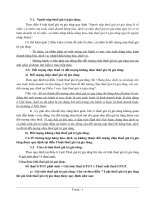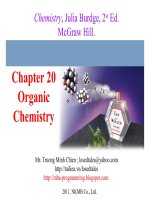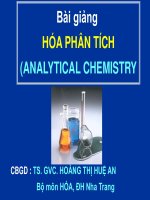BÀI GIẢNG ORGANIC CHEMISTRY chapter5
Bạn đang xem bản rút gọn của tài liệu. Xem và tải ngay bản đầy đủ của tài liệu tại đây (535.67 KB, 42 trang )
ORGANIC CHEMISTRY
Dr Nam T. S. Phan
Faculty of Chemical Engineering
HCMC University of Technology
Office: room 211, B2 Building
Phone: 38647256 ext. 5681
Email:
1
Chapter 5:
ALKENES
An sp2
hybridized
carbon
2
NOMENCLATURE OF ALKENES
The IUPAC name of an alkene is obtained by replacing
the “ane” ending of the corresponding alkane with “ene”
• Ethylene is an acceptable synonym for ethene in the IUPAC
system
• Propylene, isobutylene and other common names ending in
“ylene” are NOT acceptable IUPAC names
3
Determine the parent
hydrocarbon – the
longest continuous
carbon chain containing
the C=C
4
Note: Alkenes can have geometric isomers
5
PREPARATION OF ALKENES
Dehydrations of alcohols
Acid
isomerization
6
isomerization
7
Eliminations of alkyl halides
Base
8
Alkyne hydrogenations
Pd/CaCO3 + Pb(OAc)2 / quinoline
9
REACTIONS OF ALKENES
Additions of hydrogen halides (AE)
More stable
Markovnikov’s rule
10
Carbocation rearrangement
More stable
11
More stable
12
Stereochemistry
Racemic mixture
13
Already has 1 asymmetric carbon
14
2 asymmetric carbons are created
15
Additions of hydrogen bromide (AR)
Electrophilic addition (AE)
Radical addition (AR) – only for HBr
16
Reaction
mechanism:
17
Additions of halogens
18
Major
addition
product –
NOT a
dihalide
19
Stereochemistry
20
21
Stereochemistry
2 asymmetric carbons are created
Trans-2-butene Æ meso compound
22
Additions of water – hydration reactions
Water is too weakly acidic to allow the hydrogen to act
as an electrophile
Markovnikov’s rule
H2SO4, H3PO4…
23
Reaction
mechanism:
Carbocation
rearrangement
might occur
24
Alcohols by oxymercuration-reduction
Markovnikov’s rule
No carbocation formation, no rearrangement
25









